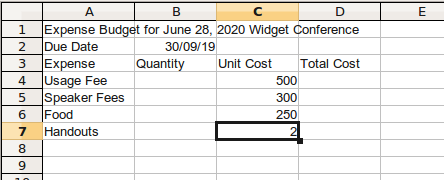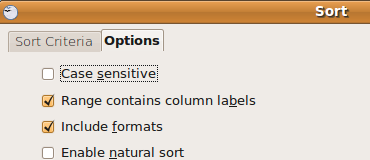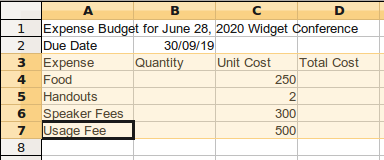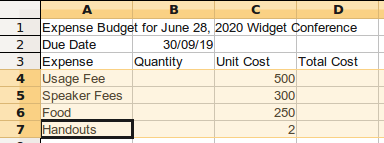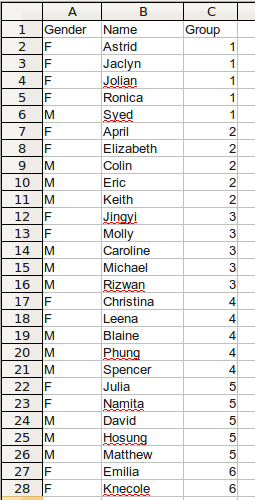Sorting data
| Working with Spreadsheets in OpenOffice.org Calc | |
|---|---|
| Working with cells | Selection | Inserting | Deleting | Widths and heights | Entering data | Changing contents | Copy, move, delete | Shifting cells | Sorting data | Speeding data entry | Find and replace | Practice | Summary |
The power of spreadsheets comes from the ease with which we can manipulate data. The ability to sort alphabetic and numeric data by one or more criteria, in ascending or descending order, is a key feature.
Sorting data involves two main actions.
Action 1: Decide on the criterion(s)
In choosing one column by which to re-order the data, you are specifying a sort criterion: the data will be re-ordered, in ascending or descending order, according to the contents of the cells in this column. In Calc, you can sort by up to three criteria, with each criterion applied one after the other. For example, a sort might be specified to re-order first by "class number", second by "last name", and third by "first name", creating data sorted alphabetically within class.
Action 2: Identify and highlight the range of cells to be re-ordered
The cells in each row in a spreadsheet typically go together (e.g., different pieces of information about an individual participant) so when sorting it's important that all of the data in a particular row be re-ordered the same way (e.g., a person's last name in A2 stays with their first name in B2 and birthdate in C2). The key action in this second step is to highlight all of the data that needs to be kept together during the sort. Usually this is done by selecting the whole sheet (using the key combination Ctrl+A) or if some of the sheet contents should be left as is, selecting all of the relevant columns (e.g., when a summary table is positioned to the right of the data).
Do an alphabetic sort
Continuing with the conference budget example, let's sort the expenses alphabetically, so we can more easily find specific information. (It's not so hard to find things with only 4 rows of data, so pretend the list is much longer.)
Do a numeric sort
But what if we wanted to view the data in order of cost (so we can easily find the highest priced items).
| The first step is always to make a plan for the sort procedure:
1. What is the criterion?
2. What data will be included in the sort
The Sort dialog displays. We don't have column labels, so we can go right to choosing the criteria in the "Sort Criteria" tab.
| ||||
Sort on multiple criteria
The sort routine in Calc can sort on up to three successive criteria, by specifying the different criteria in the three Sort by selection windows in the Sort dialog. This can be useful to organize a listing according to a number of factors (e.g., surname, first name, class...)
| The data shown below were sorted using three criteria, Gender, Name and Group.
| ||

